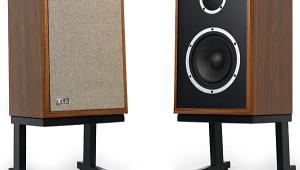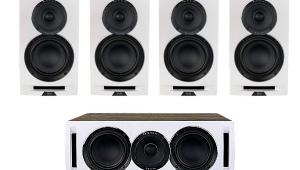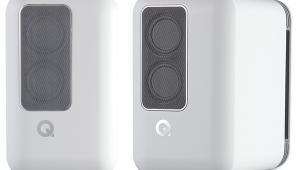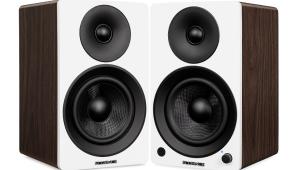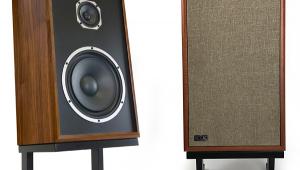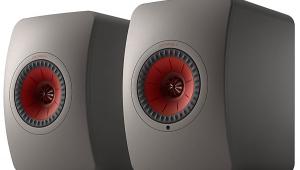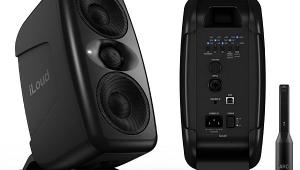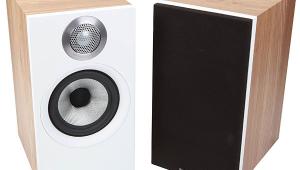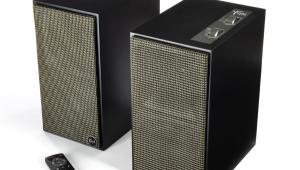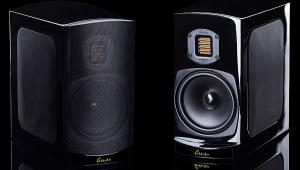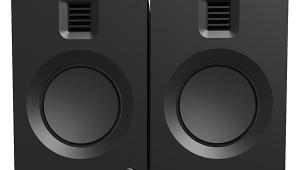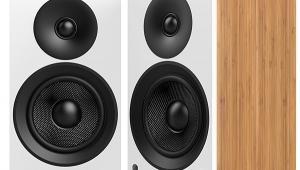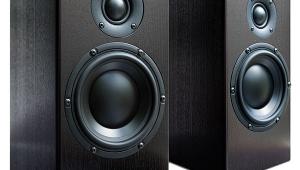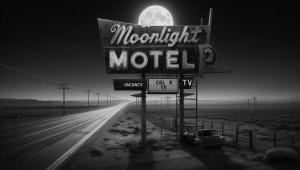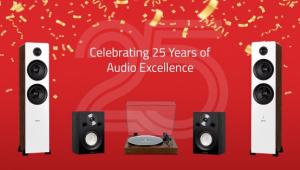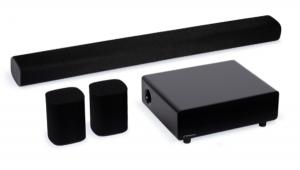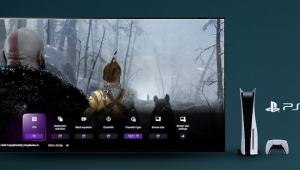I find the use of your term "underdog" quite humorous. Where have you folks been? This company has been in existence for 33 years(on their own and surprisingly not belonging to any larger CE conglomerate) and perhaps a review of their larger floor-standing speakers such as the M80, the new M100 and the widely acclaimed LFR1100 are in order here in which the latter in many ways, is breaking new ground in design and performance, especially for the money.
Axiom Epic Midi 125 Speaker System Page 2

The Speaker Vanishes
Right out of the box, the Axioms were self-effacing speakers, the kind that duck out of the way and let content speak for itself. With the disappearance of a faint midrange coloration after the first few hours—break-in time was mercifully short, mutation minimal—they turned out to have so little personality of their
own that I hesitate to attribute any characteristics to them. If I say the monitors had decent bass response down to the sub crossover, I’m not implying that they boosted bass, only that they delivered what there was in the signal. Nor were there any additive traits in the highly versatile midrange or
the wide-open top end of the monitors and center. Off-axis response was relatively un-beamy for this kind of conventional dome- and cone-based design—in two-channel mode, the monitors had a sweet spot, but not a tyrannically small one that would immobilize the listener. The so-called Quadpolar surrounds were less wishy-washy than most bipoles I’ve tried, supporting strong and well-distributed, but not overwhelming, surround effects.
The subwoofer did a fine job of producing clean and pitch-correct bass up to the crossover point, though its modest output confirmed that it would fare best in a room with less cubic footage than mine, as suggested by the manufacturer. This is after all a sub with a single 8-inch driver and a modest rated power of 125 watts RMS. The sub was not capable of overwhelming force, but when it was pressed with massive action-movie bass effects, limiter circuitry kept it out of trouble.
Amsterdam Heavy (DVD, Dolby Digital)—loaded with action acrobatics from professional fighters and kickboxers in a setting I’d gladly move to—prompted me to write in my notebook: “Action movie friendly? Check.” Not that this soundtrack was a marvel of its kind. Even discounting the occasional edginess of Dolby Digital lossy compression, it was on the crunchy side, perhaps owing more to video-game aesthetics than to movie aesthetics. But the Axioms were just telling it like it was. They were candid, not ruthless. Effects from the surround speakers had a nice combination of continuity and discretion.
The next two demos were Blu-ray Discs with DTS-HD Master Audio soundtracks—and better-recorded and -mixed soundtracks, perhaps owing to higher budgets. It was like listening to a whole different speaker. The soundfield was bigger, objects within it better drawn, and the top end was more refined, allowing me to relax a little. Men in Black 3 showed off the subwoofer’s strong suit: The handoff from sub to speakers was so slick, I had a hard time telling where one stopped and the other began, at least in the vicinity of the crossover. It also became obvious that the sub would never win any low-frequency weight-lifting contests, but voices sounded natural and unhyped in all the movie and music demos.
The Raven, with John Cusack as Poe, kept the action going with thundering hooves—and here I appreciated the sub’s restraint. This is the kind of bass effect I’d rather have controlled than oversold. When the thundering hooves mixed with cellos and basses, the system’s resolution and output capability kept the horses from overpowering the stringed instruments, juggling both in the same busy soundfield. And it was a soundfield that lifted clear of the speakers, taking full spatial advantage of scenes located in large indoor spaces.
I’m a Citizens for Boysenberry Jam Fan
A mint-condition vinyl copy of Simon & Garfunkel’s Bookends gave the speakers a chance to swing their spotlight around, suddenly illuminating individual elements in the mix, then just as suddenly changing personality once those elements disappeared. This made some instruments seem to come out of nowhere, such as the fat bass line on “Punky’s Dilemma” or the echoing, nightmarish, intentionally strident gospel chorus on “Save the Life of My Child.” When the sub was silenced, the speakers had enough bass of their own to fill in the two classic voices and Paul Simon’s subtle, tasteful acoustic guitar.
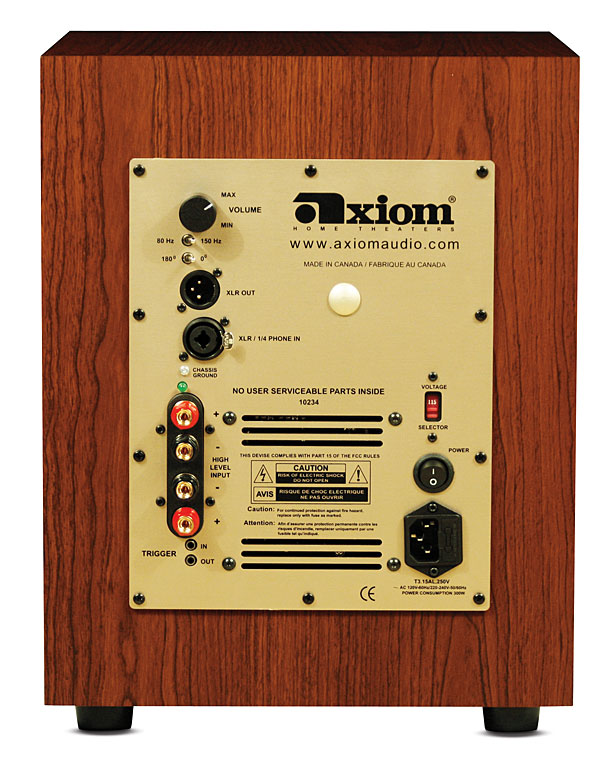
Bruckner’s Fifth Symphony came in a live performance by Sergiu Celibidache and the Munich Philharmonic from a 12-CD EMI wallet box. That this demo was able to hold my attention for 88 minutes spoke well of both the performance—a Bruckner that was relished, not rushed—and the speakers, which mined the recording for all the dynamic and spiritual momentum it had. Although I don’t often have physical responses to Bruckner, I found myself nodding my head to Celibidache’s stately pace. Even when the volume dropped to a whisper, with the occasional audience cough peeping through the soundstage, the two M2s didn’t loosen their grip on my attention—low-level resolution was among their most moving qualities. In the loudest moments, the titanium-domed tweeters delivered the brass section with gusto. When the volume level and emotional pitch were at their highest, the string section could get a bit hot, though not to the threshold of discomfort. I should add that I was playing the system at levels that seemed to be approaching concert-hall volume, something I wouldn’t attempt with just any speaker. In any case, this was an indelible listening experience.
John Coltrane’s A Love Supreme arrived on an MCA re-release of the original Impulse LP. I bought it in the early 1980s but haven’t come to appreciate it until recently—“there’s always hope” is one of my listening mottoes. In Rudy Van Gelder’s classic recording, the sax emerged close up and unveiled but not edgy. The M2’s presentation of cymbals fascinated me: The tap of Elvin Jones’ drumstick—“not often you can hear the stick,” I told my notebook—was followed by a soft metallic exhalation, with a medium perspective, sitting just slightly behind the speakers along with Jimmy Garrison’s bass and McCoy Tyner’s piano. The bassist definitely needed the subtle extension afforded by the sub to achieve the right weight and be heard above the other instruments.
Axiom Audio’s Epic Midi 125 speaker system gets our attention for a number of reasons. There’s the underdog angle. Perhaps more important is the company’s wherewithal to design and build its own drivers, giving it more control over the final result. And then there are the idiosyncratic design features, some of which—the unusual enclosure shapes, the Quadpolar surround design—likely make the system sound better. But all that fades into insignificance when we consider the primary question: Does this system deliver high performance and value for your money? The answer is an emphatic yes for the speakers and a qualified yes for the sub—for larger rooms, you might pick a larger model from the Axiom line, though there’s no doubt the company can muster an honest bass-maker. Add the Epic Midi 125 to the short list of factory-direct home theater speaker systems you’ll want to try at home.
- Log in or register to post comments

I would no call the LFR1100 as widely acclaimed. Theres only about 4 people that own them and only 1 or 2 subjective reviews with no measurements so far from being acclaimed. Also for $3700+ its far from a value, with cheap vinyl, stamped drivers, and Axioms typical cheap xover parts its not a value at all. Don't forget you need 4 channels of amps to power just a pair of LFRs.
The M80 and M100 are only decent towers in there price range and not exceptiona or bang for the buck performers. Combfiltering issues with the tweeters and the CTC spacing is to far from mid to tweeters. They also only come in cheap vinyl with optional finishes adding hundreds to thousands of dollars to match what most in the price point offer as standard.
Not much love for Axiom across the forums besides Axioms own boards.
I would also add I don't believe this Axiom package is a decent value. Not when you can pick up a HSU speaker and subwoofer package for $100 more that includes the VTF3 Mk4 and much larger HB1 mk bookshelfs and center. The EP125 is a sad excuse for a subwoofer (if you can call it a subwoofer) especially at $400.

Yep, you are obviously a disciple of the AVS/Audioholics crowd that has proven quite clearly by the antics of some of the principals of these websites in the past who were exposed for instigating these type of worthless comments that this group has proven for quite some time now when it comes to assessing anything about speakers, speakers, by the way, that were never even reviewed, that it has little or no credibility whatsoever.
Obviously, the opinion of the folks at HT is quite different.

So because you don't like my comment, its worthless? So anyone that comments about Axiom is instigating? Really? Point to me where I am wrong with my comments? I could say since your so adament about defending Axiom you must be a company shill to "plant" good comments on the net? Your doing whats called a ad hominem, ignoring what I actually said and bringing up something from some other boards while ignoring the substance of what I actually said.
The EP125 with a -3db at 47hrz and a price of $400 is not a bargain and is not a good performing subwoofer. The SVS PB1000 is only $99 more and has a -3db at 19hrz and double the power. The HSU STF-2 is another example of a cheaper subwoofer that performs better than the Axiom woofer.
Show me a review that has measurements of the LFR that shows its a widely acclaimed speaker? So far i've seen 2 people on Axioms board and one review of the speaker, can't really say "widely" acclaimed.

This is an interesting read which pits the Axiom M3v3 vs a host of other speakers. The Axioms are the biggest and most expensive in the comparison yet they came out nearly dead last in a blind listening test and had some of the worst measured performance.
This just goes to show you price and fancy brand name doesn't always equate to better performance.
[[shootout result]]
http://www.soundandvisionmag.com/article/review-clash-minispeakers
[[Axiom M3v3 review]]
http://www.soundandvisionmag.com/article/review-axiom-audio-m3v3

Oh, where do I begin?
For disclosure’s sake, how about I preface my reply by saying I have owned a pair of Axiom M80v2 since about 2005. I thoroughly enjoy them and many of my friends have complimented them on their hi-fidelity and sound quality. We listen to music and watch a ton of sports and everyone seems to love them.
With that being said, I just have to laugh at the responses from both of you guys. It sure sound like you've got an axe to grind with this company, or have a hidden agenda, and it shows.
You first Inzer585. To specifically come onto a review and bash away at a company as you do is the first warning sign to people that what you're saying should be taken with a grain of salt. You've stated nothing I would accept as fact but merely opinion. Statements such as “there are about only 4 people that own LFR’s”, “requiring 4 channels of amps to power them”, and “that there isn’t much love for axioms across the forums” are comical and simply opinion/hyperbole. You somehow know every owner of a LFR1100 to accurately state the number of owners? Also, people who are willing to pay $3700 for a pair of speakers are people who have the money to power 4 independent channels. Hec, I've got four Outlaw audio monoblock 2200s powering my setup, and I've only got the M80s! Have you even done a blind listening test with any of their speakers before commenting on their quality? That vinyl you talk about is also a common material used by all manufacturers for products in this price range. The Hsu research speakers you reference are also not real wood, and the upgraded veneer rosewood they offer is just a veneer, and not a real wood cabinet. I’m not sure how anybody can call a company out without actually placing facts for people to see and consider. I guess we’re all going to have to accept the fact that the EP125 is a sad excuse for a subwoofer because you said so. Geez…
Pklins, you provide a couple of links to S&V mag and state:
“This is an interesting read which pits the Axiom M3v3 vs a host of other speakers. The Axioms are the biggest and most expensive in the comparison yet they came out nearly dead last in a blind listening test and had some of the worst measured performance.
This just goes to show you price and fancy brand name doesn't always equate to better performance.”
There are a couple of things wrong with what you’ve stated, and I’m not sure whether it’s to deliberately mislead, because you can’t read properly, or because you just have an agenda against Axiom Audio. First, the prices of each of the speakers are given, and it clearly shows that Axioms are not the most expensive speakers of the group. The Hsu Research HB-1 MK2 is $398/pair, Monitor Audio Bronze BX1 is $397/pair, and the Paradigm Atom Monitors are $398/pair. Count much, cause those numbers are higher than $379? Second, the authors of the comparison provide a caveat to their analysis:
“Note that while some of these speakers definitely outperform others, there was no clearly superior product. We generally agreed on which of these speakers are real contenders, but our personal preferences among the favorites differed. Picking a “winner” in this case would be arbitrary, so instead we’ll help you figure out which one or two might be the best choice for you.”
See what the authors did? They do have clear favourites, everyone does, but there was no clearly superior product. That’s a reasoned analysis and they even state that there was no “clearly superior product”. This is an important point and I’ll say it one more time so it’s clear for you – “there was not clearly superior product”. I would assume as much since they’re all roughly in the same price range and come from respectable companies. Yes, I can agree that maybe the Axioms didn’t perform as well, but you exaggerate their non-competitiveness, which shouldn’t make one draw the conclusion that “price and fancy brand name doesn’t always equate to better performance”. Especially since it would be ludicrous to use Axiom Audio and fancy brand name in the same sentence. In my opinion, they’re a sophisticated and understated brand who go for the value conscious buyer and who relies on some pretty darn good research conducted by the NRC to back their speakers.
The second link pklins provides for the M3v3 is actually a pretty positive review for those speakers which states:
“A longtime fave of home theater enthusiasts, Axiom sells its speakers direct through its Web site.”
“With a relatively large cabinet and one of the two largest woofers in this batch of minis, the M3v3 ought to have plenty of bass. And it does. It sounds fuller and more room-filling than any other speaker but the Hsu Research HB-1 MK2, although some of the smaller speakers, such as the Music Hall Marimba, came fairly close. It also plays loud, easily reaching party level when I slid the volume control up on my laptop computer connected to the Firestone DAC for Jeff Beck’s crazily dynamic, almost comically muscular recording of “Rollin’ and Tumblin’.” Given that the amplifiers used for this test are conservatively rated at 200 watts per channel, that’s pretty impressive power handling.”
“Every product has a buyer, so who’s the buyer for the M3v3? Someone who wants a minispeaker with ample, powerful bass output and who grooves on very mellow sound.”
I’m really confused as to why pklins would come up with such a negative conclusion to such a positive review?
Just before I sign off this too long-winded reply, it’s especially poignant to recall that we’re talking about audio equipment and it’s always overblown subjective nature. I’ve followed it for decades now and the more research I do, the more I realize how much marketing and hype go into this crazy industry. I’d love to call myself an audiophile, but that term is loaded and people who actually do call themselves that are probably douchebags trying to sell me on the idea that I need those $10,000 gold speaker cables, the newest class d, triple oscillating reverse flux capacitating power amp, or that somehow I can perceive the difference between a $10,000 pair of speakers hooked up to a usb DAC vs a PC soundcard with a flac vs. 320MP3 vs. vinyl recording. It’s all a joke to me and the more a reasoned person looks at audio equipment, the more they’ll come to realize, that you’ll spend the most you want to spend for something that you’ll enjoy listening to. I know there’s “better” equipment out there, and I’ve done my listening tests at other people’s houses and in store at fancy audio stores, and my conclusion was that I was willing to pay the money I had on the Axioms. They were the best value for the money and sounded just the same as speakers more expensive and less expensive than they were. With that understanding, the biggest reason I chose Axioms were for the 30 day trial, the excellent customer service I received from them each time I called, the non-existent aggressive sales pitches, their active forum filled with helpful people, and because I could talk to the president of the company if I had an issue or just plain wanted to shoot the shit. That’s value in my opinion, and how many companies can claim that?
Oh, and btw, I just thought it was interesting to find that Inzer585 had again bashed Axioms in the very S&V comparison review that pklins linked. That’s two reviews I’ve read and twice he’s had nothing but bad things to say about the Axiom brand. Coincidence? I think not cause Inzer585 is a known troll of Axiom Audio. Just do a search on google and read up. Here’s his quote from the S&V comparison review. Classic case of trolling with an agenda.
“from inzer585 on 04.02.13 at 7:26PM
Well to me Axiom seemed like it was the biggest loser in the shootout. Its usually hyped up quite alot about how it outperformed the $2500 B&W Diamond bookshelf in the Axiom controlled DBT. Seems like that might have been alot more hype than substance.
Looks like Axioms true performance range is middle to bottom of the pack in its price range. I don't see how it could ever compete with speakers costing 5x as much.”

Holly Molly what a conspiracy for what speakers???? Seriously.
The reviewer from S&V was being diplomatic. You can see in the tone of his writeup that he wasn't happy with the Axioms or retesting them for that matter. I first read this review in the print version at a local bookstore and seem to remember they ranked each speaker. The Axioms came in near to last (behind the HSU's).
The reviewer made this comment which confirms this:
"Our listeners ranked the HB-1 MK2 in the middle of the pack, and the M3v3 toward the bottom of the pack."
My sincere apology if I read or interpreted incorrectly.
The -10dB cavity in the 5-10khz range is unacceptable IMO. All of the other speakers, especially the Paradigm Atoms produced much better measurements.
The Axioms are one of the most expensive in their standard vinyl finish. Slap on a veneer and they are priced higher than the rest in the shootout. A real wood veneer jumps the price to $538/pr. If you trick the speaker out with all the options the price skyrockets to almost $700pr!
That's a lot of money for a speaker that is shown to have deficiencies to its less expensive brethren.

oh stop the silliness. You obviously have an agenda.
I'm sure you know what the S&V reviewer was thinking. Not only are you a neutral and objective reviewer, but you're also a mind reader as well. Despite my quotes which clearly indicate that the reviewer was overwhelmingly positive, you've subjectively interpreted that as being negative. Thank you for pointing out that the reviewer is deliberately trying to mislead the masses. I guess S&V aren't as neutral and objective as they should be. They then must have the agenda and not you. Tell me something, why would a review site be diplomatic in a review by saying positive things about what they're reviewing? Do they owe Axiom Audio anything? You seem to be able to read minds. Please tell.
Also, if you're going to quote something and present it as fact you'd better be accurate. I'm not sure how you could be wrong on two separate points you make, and then follow it up by blowing them off after being called out for it. Essentially, those two points are now null because of that.
I've quoted directly from the article on a bunch of points, you should try doing the same to back up yours.
Again, it's pretty hilarious to find somebody so up in arms about a speaker that they've never auditioned. Talk about lame.

I know this thread is old but could not help the need to post this:
Axiom speakers are very well made speakers. I was skeptical but decided to make a purchase March of 2014 and went with the M3v4 for all five channels of my home Theater set up. These speakers have a very warm and neutral mid range, not too harsh highs and a very decent amount do bass that is tight and with no muddiness. I have own JBLs, KEFs , POLKs and Boston Acoustics and I can say confidently Axiom makes a better speaker (in the same price range of the competition). I can say the M3v4 beats the KEFQ300 as the Q300 was the one I was looking at as well and test both at my home. The KEF very nice mid range but did not have mid range warmth of the Axiom. The KEF did have more bass but the bass was muddled at the lower frequencies. The Axiom was built better in my opinion as well. I end up with the Axiom over the KEF because of the natural sound it produces, which put this speaker well above its price range. Anyway, I am sick of people who don't have the balls to actually put out money to listen to A pair of Axioms but still bash the company and it's speakers.
Note: Axiom is now building for Bryston..... That should tell you just now credible the company is.

